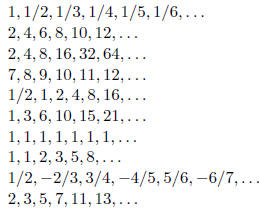Sequences and Sums
A sequence is a function t from a subset of the integers
(usually N or Z+) to a set S. In this
discussion, the set S will be a set of numbers but we could have a sequence of
colors, musical notes,
or even computer programs.
We often write  . Each
. Each
 is a term of the
sequence. The sequence
is a term of the
sequence. The sequence  may
may
be denoted by  or
or
 . The numbers, 1, 2, 3,... are the term
indices and
. The numbers, 1, 2, 3,... are the term
indices and 
are the term values
1 Sequence Examples
Can you give the next term of each of these sequences? Can you give the function
t(n) that defines
the sequence? Assume the first term is  .
.

2 Some Special Sequences
2.1 Arithmetic Sequences
An arithmetic sequence is a sequence in which each term equals the preceding
term plus a constant.
A general arithmetic sequence looks like this a, a + d, a + 2d, a + 3d,... The
first term is a and the
constant difference between terms is d.
What is the nth term of the sequence a, a + d, a + 2d, a + 3d, : : :?
What is the next term and the nth term of each of these sequences?
4, 7, 10, 13, 16, 19, ...
-7,-1, 5, 11, 17, 23, ...
2.2 Geometric Sequences
A geometric sequence is a sequence in which each term equals the preceding term
times a constant.
A general geometric sequence looks like this a, ar, ar2, ar3, ar4,... the first
term is a and the
constant ratio between successive terms is r.
What is the nth term of the sequence a, ar, ar2, ar3, ar4,...?
What is the next term and the nth term of each of these sequences?
2, 6, 18, 54, 162, ...
1,-4, 16,-64, 256,...
2.3 Quadratic Sequences
A quadratic sequence is a sequence whose nth term is given by a quadratic
function,  .
.
Here are some quadratic sequences. Can you find the quadratic function that
generates them?
1, 4, 9, 16, 25, 36, ...
6, 15, 28, 45, 66, 91,...
An arithmetic sequence is given by a linear function and the difference between
successive terms is
a constant. In a quadratic sequence the differences between successive terms are
given by a linear
function and the second differences are constant. For example:
| sequence |  |
| differences | |
| second differences |
3 Series and Partial Sums
A series is a sum of the terms of a sequence. Since a sequence has infinitely
many terms, a series
is the sum of infinitely many terms. We often sum only the first n terms of a
sequence. The sum
of the first n terms is called the nth partial sum. The following is a sum of an
infinite number of
terms.

Below is the sum of the first n terms. This is the nth
partial sum. k is the index of summation, 1
is the lower limit, n is the upper limit.

This is also a partial sum. j is the index of summation, m is the lower limit, n is the upper limit.

3.1 Arithmetic Sums
An arithmetic sum is a sum of terms of an arithmetic sequence

3.1.1 Examples

3.2 Geometric Sums and Series
A geometric sum is a sum of terms of a geometric sequence.

or, summing from 0

With geometric sequences, summing the infinite sequence
may be meaningful. infinite sums are
called series.

Let's find a formula fort the nth partial sum

Let 
Then 
 as all the other terms
cancel out when we subtract rS from S.
as all the other terms
cancel out when we subtract rS from S.

3.2.1 Examples

 .What happens when n
gets very large?
.What happens when n
gets very large?

3.3 Some Special Sums



